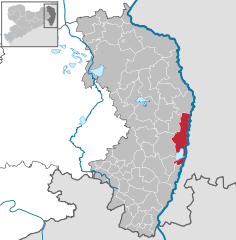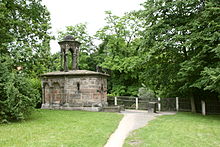- Görlitz
-
Görlitz St. Peter's Church and some cityscape 
Coordinates 51°09′10″N 14°59′14″E / 51.15278°N 14.98722°ECoordinates: 51°09′10″N 14°59′14″E / 51.15278°N 14.98722°E Administration Country Germany State Saxony Admin. region Dresden District Görlitz Town subdivisions 10 town- and 8 village-quarters Mayor Joachim Paulick Basic statistics Area 67.22 km2 (25.95 sq mi) Elevation 199 m (653 ft) Population 55,596 (31 December 2010)[1] - Density 827 /km2 (2,142 /sq mi) Other information Time zone CET/CEST (UTC+1/+2) Licence plate GR Postal codes 02826–02828 Area code 03581 Website www.goerlitz.de Görlitz ([ˈɡœɐ̯lɪts ] (
 listen); Upper Sorbian: Zhorjelc, Lower Sorbian: Zgórjelc, Czech: Zhořelec) is a town in Germany. It is the easternmost town in the country, located on the Lusatian Neisse River in the Bundesland (Federal State) of Saxony. It is opposite the Polish town of Zgorzelec, which was a part of Görlitz until 1945. Historically, Görlitz was in the region of Upper Lusatia. However, in 1815, some parts of Lusatia were integrated into the Province of Silesia, and later into the Province of Lower Silesia. Görlitz is the largest city of the former Province of Lower Silesia that lies west of the Oder-Neisse line and is hence the largest city of that province that is still part of Germany today. Therefore it is considered the most Silesian city, in terms of character, in Germany today. This is not unjustified since the city adapted to a large extent to the rest of Silesia when it was part of it administratively. It is the easternmost town in Germany and the capital of the district of Görlitz. Today the city combines Lusatian and Silesian traditions as well as German and Sorbian culture influenced by the proximity to Poland. Görlitz is the largest city in the Silesian part of the current Germany.[2]
listen); Upper Sorbian: Zhorjelc, Lower Sorbian: Zgórjelc, Czech: Zhořelec) is a town in Germany. It is the easternmost town in the country, located on the Lusatian Neisse River in the Bundesland (Federal State) of Saxony. It is opposite the Polish town of Zgorzelec, which was a part of Görlitz until 1945. Historically, Görlitz was in the region of Upper Lusatia. However, in 1815, some parts of Lusatia were integrated into the Province of Silesia, and later into the Province of Lower Silesia. Görlitz is the largest city of the former Province of Lower Silesia that lies west of the Oder-Neisse line and is hence the largest city of that province that is still part of Germany today. Therefore it is considered the most Silesian city, in terms of character, in Germany today. This is not unjustified since the city adapted to a large extent to the rest of Silesia when it was part of it administratively. It is the easternmost town in Germany and the capital of the district of Görlitz. Today the city combines Lusatian and Silesian traditions as well as German and Sorbian culture influenced by the proximity to Poland. Görlitz is the largest city in the Silesian part of the current Germany.[2]Contents
History
As a small Sorbian village named Gorelic in the region of Upper Lusatia, it became part of the Kingdom of Poland during Bolesław I Chrobry's conquest of Lusatia, after whose death the town fell to the Margraviate of Brandenburg and then Bohemia. The date of the town's foundation is unknown. However, Goreliz was first mentioned in a document from the King of Germany, and later Holy Roman Emperor, Henry IV in 1071. This document granted Görlitz to the Diocese of Meissen, then under Bishop Benno of Meissen. Currently, this document can be found in the Saxony State Archives in Dresden.[3] The origin of the name Görlitz is derived from the slavic word for "burned land,"[4] referring to the technique used to clear land for settlement. Zgorzelec and Czech Zhořelec have the same derivation. In the 13th century the village gradually became a city. Due to its location on the Via Regia, an ancient and medieval trade route, the settlement prospered.
In the following centuries it was a wealthy member of the Lusatian League, which consisted of Bautzen, Görlitz, Kamenz, Lauban, Löbau and Zittau. In 1352 during the reign of Casimir the Great, colonists from Görlitz founded the town of Gorlice in southern Poland near Kraków.
The Protestant Reformation came to Görlitz in the early 1520s and by the last half of the 16th century, it and the surrounding vicinity, became almost completely Lutheran.
After suffering for years in the Thirty Years' War, the region of Upper Lusatia (including Görlitz) was ceded to the Electorate of Saxony in 1635. After the Napoleonic Wars, the 1815 Congress of Vienna transferred the town from the Kingdom of Saxony to the Kingdom of Prussia. Görlitz was subsequently administered within the Province of Silesia, and, after World War I, the Province of Lower Silesia, until 1945.
Near the end of World War II, German troops blew up all bridges crossing the Lusatian Neisse. The redrawing of boundaries in 1945 — in particular the relocation of the German-Polish border to the Oder-Neisse line—divided the town. The right bank became part of Poland and was named Zgorzelec in 1948, while the main portion became remained part of Germany and was put in the state of Saxony. When the East German states were dissolved in 1952, Görlitz became part of the Dresden District, but the states were restored upon German reunification in 1990.
On 27 June 1994, the town became the seat of the Roman Catholic Diocese of Görlitz, but remains a Protestant stronghold.
In 2002 Lake Berzdorf, located south of Görlitz, began to flood. The Altstadtbrücke (literally old town bridge) between Görlitz and Zgorzelec was rebuilt between 2003 and 2004. It was officially opened on 20 October 2004. As soon as Poland signed the Schengen Agreement (December 20, 2007), movement between the two sides of the river has once again become unrestricted, since border controls were eliminated. Indeed, the new pedestrian bridge fails to tell the traveller that they are leaving one country and entering another!
Whilst the town was always well preserved, it was notably grey and colourless under East German rule. Since reunification many buildings have been redecorated and is now more clearly "beautiful" even to the layman. It is a popular place to which the elderly retire, being quiet and relatively affordable by German standards. Its tourist potential is rapidly expanding, being very much an eastern counterpart to towns such as Heidelberg.
Culture
Today Görlitz and Zgorzelec, two towns on opposite banks of the narrow river, get along well. Two bridges have been rebuilt, a bus line connects the German and Polish parts of the town, and there is a common urban management, with annual joint sessions of both town councils.
The town has a rich architectural heritage (Gothic, Renaissance, Baroque, Historicist, Art Nouveau), which was—in contrast to most other German cities—not destroyed during World War II. One example of this rich architectural heritage is the Schönhof, which is one of the oldest civic renaissance buildings in Germany. Another medieval heritage is a model of the Holy Sepulchre (de) which was constructed in the late 15th Century.
In 2006 the twin city Görlitz/Zgorzelec applied to be the European City of Culture 2010 for an award. It was hoped that the concept of Polish-German cooperation would be sufficient to convince the jury, but Essen won the award. Görlitz was placed second. As a result of the campaign Görlitz was renamed City of Culture in order to further German-Polish relations and to attract tourists from all over the world.
As Görlitz was part of Silesia from 1815 it has a museum dedicated to the region (Schlesisches Museum zu Görlitz) and even holds a Silesian Music festival (Schlesisches Musikfest). In addition, Görlitz is the seat of the Silesia Youth Group (Schlesische Jugend). There is also a newspaper in Görlitz called the Lower Silesian Kurier (Niederschlesischer Kurier).
Transport
- The VGG (Verkehrsgesellschaft Görlitz) provides bus and tram service in the city.
- The PKS (polnische Verkehrsgesellschaft (Polish Transport Company)) provides bus service over the river between Görlitz and its sister city, Zgorzelec.
Görlitz station is on the Berlin – Görlitz and the Dresden – Görlitz lines of Deutsche Bahn. The station also provides an international connection to Wrocław, Poland.
Görlitz in popular culture
Due to the mainly unchanged historical parts of the city, many movie-makers have used the site as background over the years. Today the most prominent example is Quentin Tarantino who shot the movie-in-a-movie Stolz der Nation (Pride of the Nation) for Inglourious Basterds (which incidentally purports to be Sicily) on the Untermarkt and Obermarkt in Görlitz' oldest parts of the city. In addition The Reader teen years were shot in the town, rapid restoration work making the shoot difficult.
People
- Jakob Böhme (1575–1624), mystic
- Johann Christoph Brotze (1742–1823), educator
- Pavle Jurišić Šturm (1848–1922), Serbian Army general
- Emil Jannings (1884–1950), first actor to win the Academy Award for Best Actor
- Oskar Morgenstern (1902–1977), economist
- Hans-Jürgen Dörner (born 1951), football player and coach
- Walter Thomas Heyn (born 14 November 1953), composer
- Torsten Gütschow (born 1962), football player,
- Jens Jeremies (born 1974), football player,
- Michael Ballack (born 1976), football player
- Lars Kaufmann (born 1982), handball player
Gallery
-
Interior of the Görlitz Art Nouveau department store
See also
- Ludwigsdorf
References
- ^ "Bevölkerung des Freistaates Sachsen jeweils am Monatsende ausgewählter Berichtsmonate nach Gemeinden" (in German). Statistisches Landesamt des Freistaates Sachsen. 31 December 2010. http://www.statistik.sachsen.de/download/010_GB-Bev/Bev_Gemeinde.pdf.
- ^ Joachim Bahlcke: Schlesien und die Schlesier, p. 214, ISBN 3-7844-2781-2
- ^ Görlitz and Diocese of Miessen—http://www.findcity.de/02826ca/?p=00000002
- ^ "Placenames of the World" by Adrian Room, McFarland Pub. 2003 page 140
External links
- Official website
- DW-World 'trial living' report.
- DW-World A New Yorker in Görlitz. Begins at 26:13.
- (Polish) Zgorzelice in the Geographical Dictionary of the Kingdom of Poland (1895)
Bad Muskau · Beiersdorf · Bernstadt auf dem Eigen · Berthelsdorf · Bertsdorf-Hörnitz · Boxberg · Dürrhennersdorf · Ebersbach-Neugersdorf · Eibau · Gablenz · Görlitz · Groß Düben · Großschönau · Großschweidnitz · Hähnichen · Hainewalde · Herrnhut · Hohendubrau · Horka · Jonsdorf · Kodersdorf · Königshain · Krauschwitz · Kreba-Neudorf · Lawalde · Leutersdorf · Löbau · Markersdorf · Mittelherwigsdorf · Mücka · Neißeaue · Neusalza-Spremberg · Niedercunnersdorf · Niesky · Obercunnersdorf · Oderwitz · Olbersdorf · Oppach · Ostritz · Oybin · Quitzdorf am See · Reichenbach · Rietschen · Rosenbach · Rothenburg · Schleife · Schönau-Berzdorf · Schönbach · Schöpstal · Seifhennersdorf · Sohland am Rotstein · Trebendorf · Vierkirchen · Waldhufen · Weißkeißel · Weißwasser · Zittau
Categories:- Towns in Saxony
- Görlitz
- Cities in Silesia
- Divided cities
- Germany – Poland border crossings
Wikimedia Foundation. 2010.












